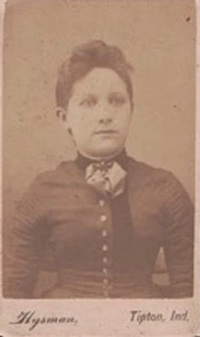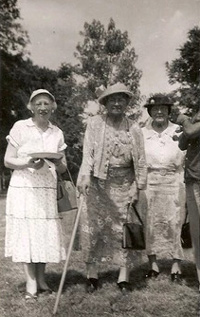Submitted by Hamilton Co. Bicentennial Commission
At the time Martha Lucetta Gilliam was born at Roberts Settlement in 1874, it was a couple generations following her ancestors’ departure from Northampton County, N.C., fleeing the deteriorating conditions for free people of color caught in the middle of the civil unrest between whites and slaves.

Martha Lucetta Gilliam at age 17. (Photo courtesy Dana Hughes)
In western Jackson Township in northern Hamilton County, free Blacks of mixed racial heritage built Roberts Settlement from the ground up, creating better lives not only for themselves but also for generations to follow.
Their guiding goals were the pursuit of economic, educational and religious aspirations with greater freedom and fewer racial barriers. By the late 1870s, 300 residents called the neighborhood home.
While the male founders of Roberts Settlement get most of the focus, during this Women’s History Month, we celebrate Gilliam and the women of Roberts Settlement. They are examples of the kinds of people and leaders Hamilton County can be proud of from our past to inspire our future.
Shaping young minds and hearts
“When our pioneers had to move here, those who knew how to read and write had to pass that on to everyone else,” said LaVella Hyter, a great-granddaughter of Gilliam and the president of Roberts Settlement, which gained nonprofit status in 1938. “Education has always been of vital importance to our settlement and our descendants.”
Gilliam and her husband taught at School House No. 5. The school for children of color became so prominent in the community that nearby white families sent their children to the one-room building as well. At that time, Indiana laws made it nearly impossible for Black children to overcome barriers to education so they often had to take matters into their own hands.
Hyter also mentions her “auntie,” Ethel Lambert, a daughter of Gilliam. Lambert was born at Roberts Settlement and attended what is now Indiana State University and Butler University.
Her impact on how Hyter sees the world and her place in it persists today. Lambert fearlessly traveled to Mexico and several countries in Europe during the mid-20th century and dedicated more than four decades of her life to teaching children in the Indianapolis Public Schools system. At the time of her 1974 funeral wake, many of her former elementary-school students came to pay their respects.
Leading spiritual needs of the community
Hyter spent her first 14 years at Roberts Settlement in Atlanta, Ind., one of eight children. Roberts Chapel was the nucleus of the community, where spiritual activities and family gatherings took place and still do to this day.
Through the years, she says, several female pastors served at Roberts Chapel, which started as a Wesleyan Methodist Church. Chief among them was a dynamic orator named Clara Cooke, now buried in the cemetery, a three-acre historic site.

Lucille Roberts, Clara (Roberts) Cooke and Alzadia (Roberts) Winburn; photograph taken in 1955. (Photo courtesy Lezli Davis)
Farming alongside the men
Two key reasons the Roberts Settlement founders chose the land was for the quality of the farmland and the fact that Quaker families lived nearby. Able farmers were needed to bring it to life, of course – to tend to corn, soybean and hay crops, as well as dairy cows, pigs and chickens.
“When you live on a farm, you find that women are your partners. Many were shoulder to shoulder with the men,” Hyter said. It was all hands-on-deck during plowing, planting, and harvesting seasons.
Perhaps even more important was their business savvy. It was the women who knew every penny coming in and going out, ensuring that a bartering deal for salt, sugar or kerosene, or the sale of a dairy cow was accounted for and fair.
A legacy of women to shape the future
One tradition among the women at Roberts Settlement was to gather together before winter came, bringing with them pieces of cloth of all shapes, colors and sizes. They would pull up chairs around a large frame and sew colorful quilts to hand over to the families they determined would need an extra layer of warmth when the cold set in.
All the families at Roberts Settlement looked out for one another, Hyter said. The settlement continues to focus on community outreach, sharing its legacy and history with the community to show what pioneers have done – pioneers who happened to be people of color.
To help tell the story, Roberts Settlement is currently developing an outdoor, interactive “legacy walk” exhibit with the initial support of the conceptual design from the Hamilton County Community Foundation. It is also preparing to celebrate its 100th consecutive homecoming in 2023.
Stay tuned to the Roberts Settlement Facebook page to stay in the know on these things and its Bicentennial programming.
